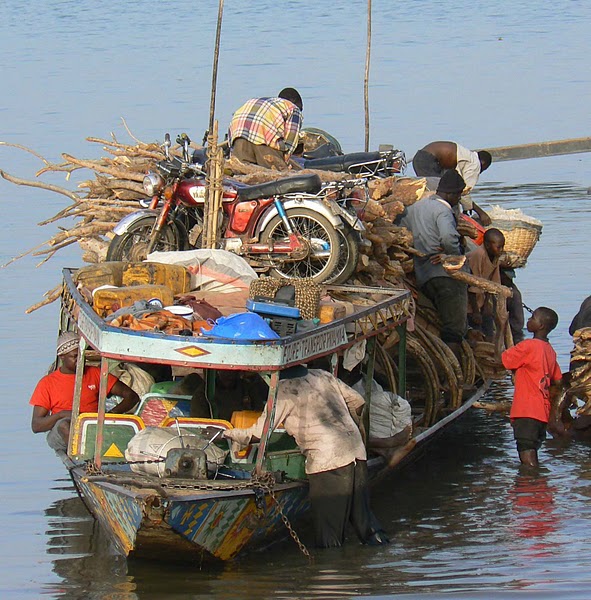
The faint blips of the radio tracking signal tell us we are close to the pig, or what's left of it.
Iain Phillips, an entomologist with the Water Security Agency, turns off the boat's motor and we scan the North Saskatchewan River for this special pig. So far, the only farm animals we've seen are the cows from nearby ranches hoofing it down paths along the shore.
We drift past a man resting, perhaps from an early morning hunt, on the shore beside his bow and kayak.
"Are you looking for fish?" the hunter yells across the river.
"No! We're looking for a pig," Phillips says.
"A pig?" "Yeah, there's a dead pig with a radio transmitter inside it somewhere in the river."
I think I hear the hunter laughing as Phillips yanks the motor back to life.
In September, RCMP threw a dead pig named Daisy into the North Saskatchewan River near North Battleford. It sounds like the start of a bad joke, but it's really the beginning of a science experiment with the potential to improve forensic work and missing persons investigations in Saskatchewan and elsewhere.
When a body disappears into the river, finding it is often a matter of chance. Investigators want to make their search efforts more predictable.
A pig is the next best thing to a human body, scientifically speaking, so when the Saskatoon RCMP historical cases unit and forensic anthropologist Ernie Walker decided earlier this year to go whole hog and find out how bodies travel in water, they acquired a pig carcass, sewed a tracking device to its vertebrae, and dropped it in the river to float away.
"There are a million different factors, and all we're trying to figure out is how far a body can go," Walker said in a recent interview.
"Quite a few individuals that go in the river in Saskatoon end up around Melfort. I've done probably four of those, and I've always wondered, 'Why there?' Who would think a body from Edmonton could end up in Langham? I didn't until I worked on that file."
The project is simply a test for now, and is likely the first of its kind in North America - possibly the world - to use a pig to study a body's movement in a freshwater system, said Walker, who is an RCMP special constable and University of Saskatchewan professor. If deemed worthy of more study, the project could launch more pigs off different riverbanks at different times of the year in varying water levels.
"It's pretty unusual for law enforcement to be doing this, but the Saskatoon 'F' Division does a lot of good stuff," Walker said.
The experiment is also tied to real investigations, including the case of 83-year-old Bernice Carnahan, one of five people presumed to have disappeared in the North Saskatchewan River system since 1981. RCMP found Carnahan's abandoned car in the Battlefords area near the river in August 2012, and police dogs tracked her scent to the water's edge.
Searching for Daisy On a crisp September morning, two weeks after the porcine plunge, a truck hauling a boat pulls out of the Water Security Agency office at Innovation Place in Saskatoon. Iain Phillips is driving, graduate student Aaron Bell rides shotgun, and they're explaining why a couple of entomologists are preoccupied with pork.
A bug's life can tell us interesting things about a person's death. When RCMP approached the Water Security Agency with questions about tracking a pig carcass in the river, Phillips saw a chance to research a relatively unexplored area of freshwater forensic entomology.
"The insect life-cycle reflects the history of a body from last breath to discovery," Phillips says. "They'll moult many times. It's a predictable timeline. If you find a fly in its fourth or fifth (life-stage) and you know the rough temperature, you'll have a good idea of time of death."
Today's plan, Phillips explains on our way to a boat launch near Denholm, is to find the pig, study the insects or whatever else is on the carcass, haul it back to Saskatoon and dissect it for further research.
Throughout the day, Phillips and Bell describe their work and the research potential of the pig project. First, the discovery. If we find the pig, what will we see? "I expect it will be a little ravaged by animals," he says. "I expect they'll have gone for the organs first and it'll be eviscerated. We'll recover what's left."
Terrestrial forensic entomology research is "very robust" and often cited by lawyers in court, but knowledge of freshwater body decomposition is relatively sparse. While researchers have anchored pigs in freshwater to study decomposition rates, there are more variables in play when a pig floats through different habitats.
The flora and fauna on land, and how that environment interacts with a body, are not the same as in freshwater, and the differences can vary widely when comparing one body of water to another, Bell says.
"Typically, (what's on a) body found in the desert would have a different timeline than a body found in the river."
There is potential to fill in the knowledge gap and, over time with peer-reviewed research, this could help solve missing persons cases and narrow down the locations where John and Jane Does fell into the water.
Phillips believes they have the technology to not only determine approximate time of death but also to tell investigators if, for example, a body found in Saskatchewan came from Edmonton.
But first, we have to find Daisy. Up stream and down stream, checking both sides of the sandbars dotting the river, we travel about 40 kilometres. Bell has his head pressed against the telemetry equipment to hear the radio signals over the motor's buzz.
The signal picks up in a particular area near the boat launch, but there's no sign of Daisy on either riverbank or the sandbars. RCMP officers spotted Daisy a few days earlier, but she's apparently disappeared. "My guess is two things: It got chewed up and the tracker got buried in the sediment, or coyotes dragged it off into the woods," Phillips says.
The pig-sized cooler comes back to Saskatoon empty.
Tracking signal remains silent In the following month, Phillips and his team head out a few more times to look for Daisy on the river and in the woods. During the last search, they couldn't pick up even a faint tracking signal.
Without the test pig, the future of the project - the simple tracking of bodies in the water and the potential forensic research - is unknown. Walker is considering anchoring pigs in the river to get baseline data for decomposition rates in Saskatchewan waters. Phillips hopes the RCMP decide to launch more pigs in the river come spring.
"In the beginning, this was all going to be a learning experience," Phillips says on the phone several weeks after the first search.
"I don't think anyone thought it'd get tied up 10 to 15 kilometres from where we threw it in. In particular, we leaned how far it didn't go."
Sunday 13 October 2013
http://www.thestarphoenix.com/technology/Trail+Daisy+goes+cold+North+Saskatchewan/9030323/story.html









